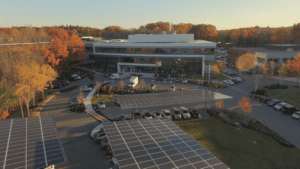Have you ever imagined a life (or maybe a few days) without electricity? To no longer be able to turn on heating in the freezing winter or having to climb up 30 floors of staircase because power is down for your apartment. What about having to throw away kilograms of rare ingredients as your fridge/freezer at your luxury restaurant stopped working, because the main grid broke down due to extreme weather?
Have you ever considered the financial loss or inconvenience an “out of power” incident can bring?
Luckily, you can always turn to a Microgrid for your community, company and/or residential apartment building to mitigate these situations. Let’s explore together, how this technology can bring you resilience and other benefits.

So what is a Microgrid?
It is a self-contained electrical network that allows you to generate your own electricity on-site and use it when you need it most. It will connect, monitor, and control your facility’s distributed energy resources (e.g. solar, wind, biomass) while enhancing performance, sustainable footprint and/or resilience
There are three key architecture types varied by connectivity to the main grid, enabling the technology to serve different needs of users including:
- Grid-connected systems, which are typically used in residential and commercial buildings, for optimization of energy cost and sustainability footprint
- Islandable systems, allowing you to switch between stand-alone or grid connected modes, to help manage black-outs, while optimizing cost and sustainability footprint
- Off-grid systems, which are typically used for remote and/or non-electrificated communities to provide local access to power
Why do organizations and communities use Microgrid?
The above architecture types probably give you a good idea, it is for i) Resilience, ii) Cost Saving, iii) Remote Electrification and iv) Clean Energy.
- If you live in California or have been to Britain during the winter, blackouts during extreme weather may be no stranger to you. While most of us enjoy reliable and constantly available power supply from the main grid, for areas with aging infrastructure or prone to natural disasters, ensuring the availability of power when the grid is down is critical. More specifically, for sectors such as healthcare, community, or petrol stations in remote highways, having resilient power sources may be a matter of life and death. When a Microgrid is installed, during power outages, organizations and communities are able to continue generating and using electricity locally, enabling them to continue providing services, especially in time of need.
- Do you think it is expensive to install a Microgrid system? Well it depends. In some countries, the average cost per kW hours can go beyond 20 US cents/hour (e.g. Australia, Japan, Germany); meanwhile in some states / countries, peak and off-peak hours can have drastically different rates (e.g. California, Brazil); in addition, some countries may offer feed-in tariffs where consumers can sell back excess electricity to the utility. These all provide opportunities where a Microgrid can provide savings and/or income stream for its owner/s.
- Level of access to electricity is very different across countries. In places such as Kenya and the Philippines, % of population with access to electricity are only 75% and 95%, and in Nigeria and Myanmar, they are below 60%. For these communities, which are out of reach for the main grid due to economic or locational reasons, installing a Microgrid will be the simplest and fastest way in providing access to power.
- Last but not least, Microgrid is able to incorporate various renewable energy sources, and helps to increase auto-consumption. For example, solar is the dominate generation technology for US and Australia, where China focuses more on Solar wind hybrids. With companies increasingly emphasizing their climate and sustainability agenda, and the global push for decarbonization, Microgrid can help companies and countries to meet their sustainability targets
Of course, many may say that there are other solutions which can bring about each of the benefits (e.g. a diesel generator for resilience), which is true. However, when you want combinations of the above benefits (e.g. a solar hybrid powered microgrid for resilience and sustainability), then Microgrid would be the best solution.
As of today, many industries and communities across the world are rapidly adopting this technology. We see industries with high requirement for resilience such as the military, hospitals and campuses in the US are more advanced in the application, while remote electrification and commercial & industrial uses in countries such as Australia, Germany and China are catching up. In addition, the recent innovation of “Energy-as-a-Service”, which takes away the financial and operational burden of customers installing the Microgrid, and transfers CAPEX to OPEX for the users, companies and communities will find this technology much more within reach.
So have you considered/been actively using this technology? Please share with us your experience, and/or find out more about the Microgrid solution here.



